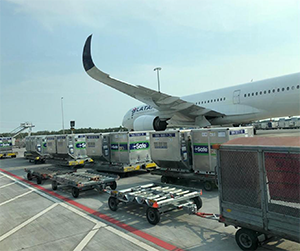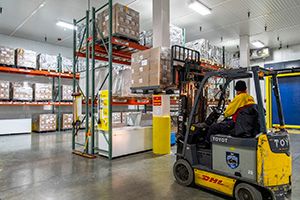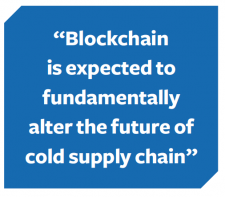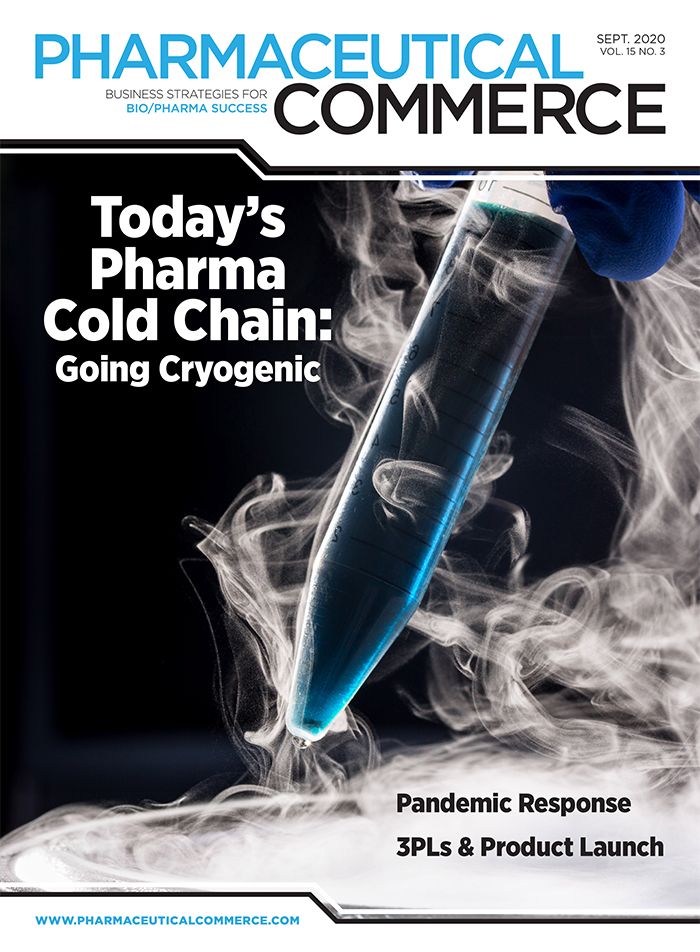Today’s pharma cold chain is going cryogenic
Both COVID-19 vaccine delivery and the growth of cellular/genetic therapies call for lower storage and shipping temperatures
Providers of temperature-controlled packaging, storage, and shipping capabilities for the biopharmaceutical industry are about to face their potentially finest moment. Though they are used to navigating a uniquely complex supply chain, today’s demands—framed by a worldwide pandemic—are unprecedented, and will require next-level support across critical functions such as logistics planning and data monitoring, analysis, and communications.
“Between the pressure to develop and commercialize a COVID-19 vaccine, the continued global demand for seasonal flu vaccines, and efforts to advance many promising cell and gene therapies (CGTs), it’s clear that companies throughout the pharmaceutical cold-chain infrastructure are juggling multiple priorities—all of them critical to lifesaving efforts,” says Vivian Berni, director of product management for Sonoco ThermoSafe, also noting existing responsibilities in managing the usual volume of temperature-sensitive therapies and vaccines already on the market.
Rather than relying solely on express deliveries made directly from the manufacturer to the point of care, the pharmaceutical cold chain typically involves multiple players, working in close coordination, to execute a number of handoffs. Pharmaceutical shipments are moved from the manufacturing site, through storage depots, trucks, planes, and ships, to reach the ultimate destination, usually a hospital, clinic, or pharmacy. As pharma companies entrust their cargo to others, there is very little room for error in each of these segmented journeys.
“The COVID-19 pandemic has created new logistical challenges and new country-specific regulations,” says Nick Porter, senior vice president of global commercial at World Courier, a part of AmerisourceBergen. “This has reinforced the importance of partnering with a specialty logistics provider that has a global network and a team that can mobilize contingency plans quickly, if needed, to identify an alternative route or to communicate with local officials.”
With multiple stakeholders involved in cold-chain shipments—and numerous touch points along the way—no single party has ultimate control over the integrity of the shipment, notes Dharmesh Chauhan, sales director at Softbox, a provider of temperature-control packaging systems and thermal covers for the life sciences industry. “This raises the stakes for all companies involved,” he says.
AmerisourceBergen, to better support customers, recently integrated World Courier, a global logistics provider, and Integrated Commercialization Solutions (ICS), a third-party logistics (3PL) company—creating a single specialty logistics partner. According to executives, its cryogenic supply chain includes vapor-charged cryogenic storage systems and temperature-controlled packaging solutions that enable product transport from manufacturer location to its 3PL storage facility and then to each point of care.
Reducing the number of handoffs can help eliminate potential weak points in the cold chain, says Wes Wheeler, president of UPS Healthcare. To that end, he expects to see more stringent standards and regulations—and increasingly optimized supply chain practices—installed to ensure quality management systems are standardized for high-value biopharma products such as CGTs and immunotherapies.
Rising to the challenge
Today, the stakes are higher than ever in the pharma cold chain—at all ends of the spectrum. Large-scale-wise, the cold chain industry is bracing for the arrival of the first of several COVID-19 vaccines resulting from the US’s Operation Warp Speed initiative and parallel efforts elsewhere in the world. Once approved, billions of doses of a new COVID-19 vaccine will need to be delivered to patients across the globe—quite literally on a moment’s notice.
Meanwhile, smaller in scope, the complex cold-chain requirements associated with managing shipments of ultrasmall volumes of temperature-sensitive CGTs are creating new demands, as the pipeline for these advanced therapies continues to grow. Under a typical CGT scenario, a single vial of biological materials (blood or tissue) must be extracted from the patient, and then safeguarded through its journey. That involves transfer from the clinical setting to a laboratory, where the sample is manipulated biochemically or genetically, and then sent back to the clinic for infusion.
While losses associated with temperature excursions during cold-chain storage and transportation efforts remain a hidden cost of doing business—in terms of spoiled product, excess inventory, and delayed deliveries—today’s cold-chain suppliers are also expanding their arsenal of data-collection tools, and leaning more heavily on the use of telemetry, advanced monitoring systems, and sophisticated data-driven modeling tools, to reduce the frequency and likelihood of preventable delays and temperature excursions.
“There is continued focus on controlling the total cost of cold-chain supply logistics, which, as a rule of thumb, account for roughly 5–10% of the total cost of biologic therapies and vaccines,” says Richard Ettl, CEO of SkyCell AG, noting that if there is a temperature excursion, the product cannot be released to patients—instead, a replacement pallet must be shipped immediately. “This makes a real difference when we’re talking about pallets of vaccines that may be valued at $500,000 each,” he adds.
While today’s new shipping and data-management devices are providing real-time visibility into the status and condition of a shipment, it is critical that these tools are able to be reprogrammed on the fly to better ward off potential obstacles, contends Mark Sawicki, PhD, chief commercial officer, Cryoport. He says such capabilities are in the process of being established through augmented GPS using Bluetooth, WiFi, Internet of things (IoT) technology, next-generation data loggers, enhanced software management services, geofencing capabilities, and expanded use of radio-frequency identification. Sawicki adds that the eventual rollout of 5G-enabled sensors should help to open up access to larger amounts of location and temperature data.
David Goldberg, CEO of DHL Global Forwarding in the US, believes industry investment in rapid digitization of supply-chain data analytics has been solid, and sees a concerted effort among shippers to use passive cold-chain packaging to augment active packaging options. “Improved data analytics allow for near-real-time mode optimization, and more effective use of ocean versus air freight,” he says.
Market dynamics
Under the cold-chain umbrella, the “refrigerated” category (2 to 8°C) is by far the largest category by value. However, among today’s newer CGT offerings, other novel biologic therapies, and several of the COVID-19 vaccine candidates currently in clinical trials, there is increasing demand for maintaining product at “deep frozen” temperatures (on the order of -40 to -80°C), and “cryogenic” (requiring liquid nitrogen; -160 to -180°C).
As of early 2020, annual global sales of biologics and vaccines—which require strict temperature control—exceeded $340 billion. Amid the continued growth of these markets, cold-chain logistics account for nearly 18% of all biopharma logistics spending, according to the 2020 Biopharma Cold Chain Sourcebook published by Pharmaceutical Commerce.

On the R&D side, cold-chain providers routinely support thousands of clinical trials, delivering temperature-sensitive drugs to study sites and laboratories around the globe. The 2020 market size for this sector is valued at about $3.8 billion, according to the Sourcebook, and the continued expansion of clinical trials logistics is projected to grow at a rate of about 3% per year, to about $4.2 billion by 2024.
Overall, global pharmaceutical sales are expected reach $1.58 trillion by 2024, according to IQVIA Institute projections released in March. By 2024, experts predict five of the top 10 best-sellers will be drugs requiring 2–8°C cold-chain storage and handling.
In 2019, FDA’s Center for Biologic Evaluation and Research (CBER), which handles the review of vaccines and blood products, approved 22 licenses for new biologic products, 21 of which require cold-chain handling, the Sourcebook reports. (In 2018, 20 such products were approved, 16 requiring cold-chain handling).
“Cost-reduction efforts go beyond just the cost of the packaging and freight but require an assessment of the costs of inventory and labor to complete the pack-out of temperature-controlled products as well,” says Ron Haub, segment director/general manager, Sonoco ThermoSafe. “Working closely with our clients, we try to identify ways to help them open up warehouse space, by holding temperature-controlled inventory and providing it on a just-in-time basis.” Haub notes that the expanded use of preconditioned shippers can also help to reduce the amount of refrigerator/freezer space required, and that preconditioned shippers are more simple to pack, reducing what he says is usually a 10-plus-step process to just two or three steps, saving time and labor.
Tighter process integration can also yield benefits. For example, SkyCell says it was able to create a direct savings of $120 million for one of the world’s top vaccine producers. “Before, the client had almost 30 different solutions in operation to handle its cold-chain distribution and management operations,” says Ettl. “We standardized and streamlined the overall approach to provide near-real-time IoT insights that let us pivot to redirect shipments more quickly.”
The elephant in the room
As the world awaits anxiously for the first approved COVID-19 vaccine(s), one perhaps underappreciated element of the overall challenge is whether the existing cold-chain infrastructure will be able to manage the distribution of unprecedented volumes of the vaccine, to every corner of the globe, nearly concurrently.
While specific details related to temperature, shipping, and dosing requirements for those vaccines that will end up in mass distribution are not yet known, billions of the first-approved vaccines will be quickly thrust into the supply chain to meet enormous, pent-up global demand. Stakeholders interviewed for this article described this looming challenge as “historic in scope…utterly unprecedented…a mammoth challenge… truly awe-inspiring…by far, one of the largest challenges we have faced in our lifetime.”
“Many of these investigational COVID-19 vaccines are expected to be in a frozen format, but this is not typical for many of the biologic drug products in the supply chain today (which require refrigerated but not cryogenic temperatures),” says Adam Tetz, director of worldwide marketing for Pelican BioThermal. “Once approved, the new COVID-19 vaccines will be manufactured at a rate of millions of doses per week and will need immediate worldwide distribution, so we are going to see a critical crunch, in terms of the existing cold-chain capacity worldwide.”
Patrick Schafer, CEO of CSafe Global, a provider of cold-chain shipping solutions, notes that COVID is the first pandemic the modern cold chain has had to manage. While global demand will be significant, ongoing demand for other pharmaceuticals will not wane simply because a COVID-19 vaccine is ready to ship, he stresses. “This effort will require coordination on a scale we’ve never seen,” says Schafer.
“The market is not currently prepared to handle the way the expected COVID-19 vaccine will need to be distributed, so there is a lot of concurrent activity around building up the basic systems and adding capacity to the system,” adds Sawicki. “One silver lining, though, is that this is also creating a lot of business opportunity for many companies in this space.”
To get a sense of the scale and the capacity gap the industry is facing, consider, in 2020, an estimated 194 million to 198 million doses of the seasonal flu vaccine will be transported (up from 175 million doses in 2019), according to the CDC, notes Angela Kerr, VP of product and program management at SpotSee.
According to Ettl, the industry moves about one million pallets of cold-chain pharmaceutical and life sciences products by air every year. He says if a single-dose COVID-19 vaccine is approved, there could be an additional 160,000 pallets entering the supply chain annually. If two doses are required, demand could grow to a half million additional pallets each year. “We need to work closely together to collaborate—even if we are competitors—because this unprecedented, high-stakes challenge will be too big for any one player to manage alone,” says Ettl.
Key challenges, Tetz adds, include developing plans to convert passenger planes to cargo planes to enable more cargo capacity, and establishing deep-freeze/blast-freezer farms at major distribution points worldwide.
On the shipping front, after a 35-year hiatus, American Airlines announced in August that
"

Credit: CSafe Global" alignment="right"/>
it had expanded its cargo-only service. Starting this month, the company began offering 1,000 regular cargo-only flights, serving 32 destinations worldwide, on top of 1,200 regular passenger flights that also offer partial cargo service. Schafer points out it’s not just a matter of having enough active air cargo containers, but providing containers that can maintain a potentially wide temperature range for extended durations of time. This will be particularly crucial for vaccines shipped to new or remote locations far from a major port city.
“Trying to envision the distribution needs for the COVID-19 vaccine is creating a very fluid and dynamic situation,” says Thomas Heinzen, vice president of corporate development for Cryoport, which is supporting logistics for eight COVID-19 vaccines and/or therapies currently in clinical trials. “All sorts of different methods of distribution are being explored, and the fact that multiple vaccines could be approved, each with different dosage and temperature requirements during storage, distribution, and administration, just adds to the overall complexity.”
"

Credit: UPS Healthcare" alignment="left"/>
To prepare for the significant capacity surge, several companies are in the process of building giant freezer farms. For example, UPS Healthcare is currently installing two such units in Louisville, Kentucky and the Netherlands (both near global UPS air hubs) comprised of hundreds of -80°C freezers. “Each of these will be capable of scaling up to 300 freezers and each freezer will be capable of storing 40,000 to 50,000 individual vials of vaccine,” says Wheeler. “We are also moving the same freezers in key clinical trial locations in South America, Germany, and the UK, and we are discussing humanitarian efforts as well.” UPS Healthcare’s clinical subsidiary Marken is working with several biopharma companies and their partners on COVID-19 vaccine and treatment development efforts.
Similarly, in July, DHL opened a $1.6-million, 20,000 square-foot cold-storage facility
"

Credit: DHL" alignment="right"/>
in Indianapolis, which houses three temperature-controlled chambers with variable temperature options, and FedEx revealed this summer that it would be adding 10 freezer facilities, with more expected to follow, to meet the coming demand.
Last month, the US Department of Health and Human Services (HHS) and Department of Defense (DoD), in support of Operation Warp Speed, tapped McKesson Corporation as a central distributor for future COVID-19 vaccines and related supplies.
Meanwhile, producers of specialized cold-chain packaging are also ramping up production. For example, Tetz says Pelican BioThermal is “pre-buying” supplies and components and has three global manufacturing centers it can use to manufacture
"

Credit: Pelican BioThermal" alignment="left"/>
product quickly to meet anticipated demand. “We are also actively converting our main products to provide a dry ice capacity and looking at adapting our dry ice parcel shippers, expanding the range of sizes to handle a wide array of payload volumes,” he adds.
Vaccines in development based on mRNA (using RNA-containing vectors) are particularly promising, but pose considerable cold-chain challenges. Chauhan, of Softbox, notes that while these vaccines enable rapid development, low-cost manufacturing, and large-scale production, they may require ultra-low-temperature distribution levels (around -80°C) to keep the mRNA proteins viable prior to administration. “The current global supply chain is not fully geared up to handle this,” he says.
Adding to the challenge, Kerr points out, will be the need for any type of vaccine approved for the novel coronavirus to reach many developing nations concurrently, where gaps in existing infrastructures will create additional “last-mile” obstacles. On top of those, Sawicki notes that particularly in remote regions and developing nations, there may not be freezers to maintain adequate storage temperatures at the point of care.
Sonoco ThermoSafe, Haub says, is in the process of examining how its 30-plus manufacturing locations can be optimized, and are adding tooling and potential machine capacity as needed. The company hopes to secure offsite storage locations to build inventories of shippers and refrigerants.
CGT: Small parcels, little risk tolerance
COVID-19 may be grabbing the headlines, but cold-chain and logistics challenges associated with safeguarding CGTs and tissue-engineered products are testing the industry’s capabilities as well. Emerging in recent years, CGTs, also called “vein-to-vein” therapies, are durable, curative-type treatments often targeting life-threatening and debilitating genetic disorders and rare diseases.
Typically involving the production of a customized treatment for each patient, the specialized, closed-loop supply chain requirements associated with a CGT create unique challenges. Opportunities for delivery delays and temperature excursions along all the steps in the segmented journey can create potentially damaging financial and clinical risk.
Heinzen, who notes that his company (Cryoport) has supported four marketed CGTs and six more expected to file for regulatory approval by the end of the year, says cold-chain issues are particularly challenging for allogeneic CGT products, as they must be transported to multiple locations, and warehoused or stored until they are infused into one or more patients. On the plus side, according to Schafer, studies have indicated that a single donor set could be used to create therapeutic doses for more than 200 patients. This means multiple doses could be moved in one thermal shipper, significantly reducing costs to the manufacturer and ultimately the patient, he says.
Nevertheless, the specialized nature of CGTs “create more cold-chain complexity than ever, particularly in terms of organizational structure, business processes, digital capabilities, and risk tolerance,” says Berni.
Adding further complexity are other variables associated with CGTs, such as shock and orientation of the sample, which needs to be monitored in near real-time, notes Sanjay Srivastava, PhD, managing director for cell and gene, life sciences, Accenture. “The industry is evolving but currently has limited experience and capabilities to incorporate these types of sensors in the supply chain to manage the deluge of anticipated CGT shipments,” he says.
The steady growth of the CGT sector is expected to continue. According to the Alliance for Regenerative Medicine (ARM), as of June 2020, there are 1,078 clinical trials underway for these types of treatments (394 in Phase I, 587 in Phase II, and 97 in Phase III), with novel efforts aimed at oncology; musculoskeletal, endocrine, and metabolic disorders; immunology and inflammation; lymphatic disease; and respiratory disorders; among other conditions. Strong financing in the CGT space also bodes well for sustained growth. Between January and June 2020, CGT developers raised $10.7 billion in financing from IPOs, venture capital, and other funding sources—a 120% increase from the first half of 2019, according to ARM. The FDA anticipates it will approve between 10 to 20 CGTs each year by 2024.
Amid the CGT explosion, Srivastava points to the need for logistics providers to run a just-in-time supply chain to facilitate cell transfer operations and deliver raw materials to manufacturers and final product to hospitals. Accenture advocates using the supply chain control tower approach, which can provide greater visibility by generating alerts about expected shortfalls and/or delays in production at suppliers and contract manufacturers and then sequence the impact these events will have. “The goal is to help logistics providers move from just providing reactive fixes to creating synchronized, event-driven value networks,” says Srivastava.
As the number of CGTs (and their volume in the supply chain) continues to grow, Albert Cooksey, senior vice president, client relations, at ICS, says the company is anticipating heightened demand for cryogenic storage systems, as well as dry shippers that can maintain internal temperatures between -150°C and -180°C for an extended period of time. To grow its cryogenic storage infrastructure and enable clients to scale their specialty products “from many to millions,” Cooksey says ICS has recently “more than doubled its refrigeration storage (2 to 8°C) and added liquid nitrogen cryogenic storage capacity (to enable -180°C).”
Dave Murphy, executive vice president, Quick Specialized Healthcare Logistics, a unit of Kuehne+Nagel and provider of transportation and logistics solutions related to the transport of live cells, says “as more CGTs are approved, their chain-of-custody requirements and volume demands increase substantially, so scalability is key—whether managing deliveries across a country or around the world.”
To that end, Berni believes service providers in the cold-chain space should reassess and redesign their IT infrastructures to “break free from silos and build bridges” in connecting data across logistics and packaging systems to enable synchronized operations.
To support ongoing capacity expansion in the CGT space, six branches of Marken have recently become Cell and Gene Therapy Centers of Excellence, and a central, dedicated CGT control center has been established at Marken headquarters in North Carolina. “These branches are supported by the industry’s largest network of liquid nitrogen (LN2) filling stations, allowing the company to maintain cryogenic supply chains that operate around the world,” says Wheeler. “We are able to support the cryogenic transportation (at -150°C) of CGT products using Marken’s LN2 shipping fleet, which is serviced at 14 geographically distributed locations.”
In August, Cryoport made two strategic acquisitions to expand its footprint in the CGT market—acquiring CryoPDP, a Paris-based provider of containers, packaging, logistics, courier services, and clinical trials support, which operates 22 facilities in 12 countries; and MVE Biological Solutions, the life sciences business of Chart Industries. MVE makes vacuum insulated products and cryogenic freezer systems. It has three manufacturing sites—two in the US and one in China.
Data is king
Perhaps nowhere in the pharma supply chain is real-time data more important than in the realm of cold-chain packaging, transportation, storage, and logistics. The goal is to allow all stakeholders to react quickly, before things go wrong, and enable a data-driven forensic review of events after the fact.
“Smart monitoring” solutions that can track internal temperature, light, pressure, humidity, and tilt—providing real-time visibility and proof of shipment stability—allow teams to mobilize quickly, according to Porter.
For example, a recent shipment using World Courier and ICS’s Cocoon packaging tool was able to maintain its internal temperature throughout a two-week delivery from Austria to Iraq, he says, which included 10 days of storage in uncontrolled warehouse temperatures.
Since 2013, SkyCell has amassed more than two billion data points about cold-chain pharma activities, says Ettl, which enables the company to identify specific risks, make the most appropriate adjustments, and improve outcomes. “This allows us to go from ‘just a gut feeling’ to data-driven efforts to optimize the supply chain in a more agile and effective way,” explains Ettl. “It’s not enough to know after the fact that something did not work. It’s far more important to use advanced IoT capabilities to not only react to losses from temperature excursions, but to create opportunities to prevent them from occurring in the first place.”
Experts believe advanced machine learning-based algorithms are already showing great promise, “with the most significant gains being made to inform advanced scheduling systems by finding patterns in track-and-trace data captured using IoT-enabled sensors and using the derived insights to quickly detect patterns and problems,” says Sawicki.
“With these capabilities, you can use past performance and variables to continually suggest more efficient routes,” adds Berni.
Richard Wood, technical director at Softbox, says the industry is experiencing a strong shift toward the use of real-time monitoring in combination with new methods for big-data analytics and predicative simulation software to mitigate risk. “We have seen examples where enhanced visibility has saved millions of pounds of pharmaceutical products from potentially damaging temperature excursions,” he says.
Later this year, according to Schafer, CSafe Global will be launching a new telemetry technology to expand its monitoring and reporting capabilities.
“When you collect the appropriate data and exploit it, you can use the data-driven

insights to select the optimum routings, carriers, and packaging solutions to meet the customers’ quality, service, and cost expectations and drive continuous service improvement,” adds Jon Chapman, vice president, pharma healthcare, at Kuehne + Nagel.
COVID-19-sparked challenges present an opportunity for the integration of blockchain technology for temperature monitoring. “Blockchain is expected to fundamentally alter the future of cold supply chain, as that would enable end-to-end traceability of temperature-controlled therapies and vaccines, and the ability to provide an audit trail of environmental condition monitoring,” says Berni. “Importantly, blockchain can help to identify which segments of the journey were in control of the shipment when any temperature excursion or damage occurred.”
In July, SonocoThermoSafe joined forces with IBM to create PharmaPortal, a vendor-neutral blockchain platform for use by pharmaceutical manufacturers and carriers. The tool “intends to record a single version of the truth on all events generated on a package’s journey,” adds Berni.
